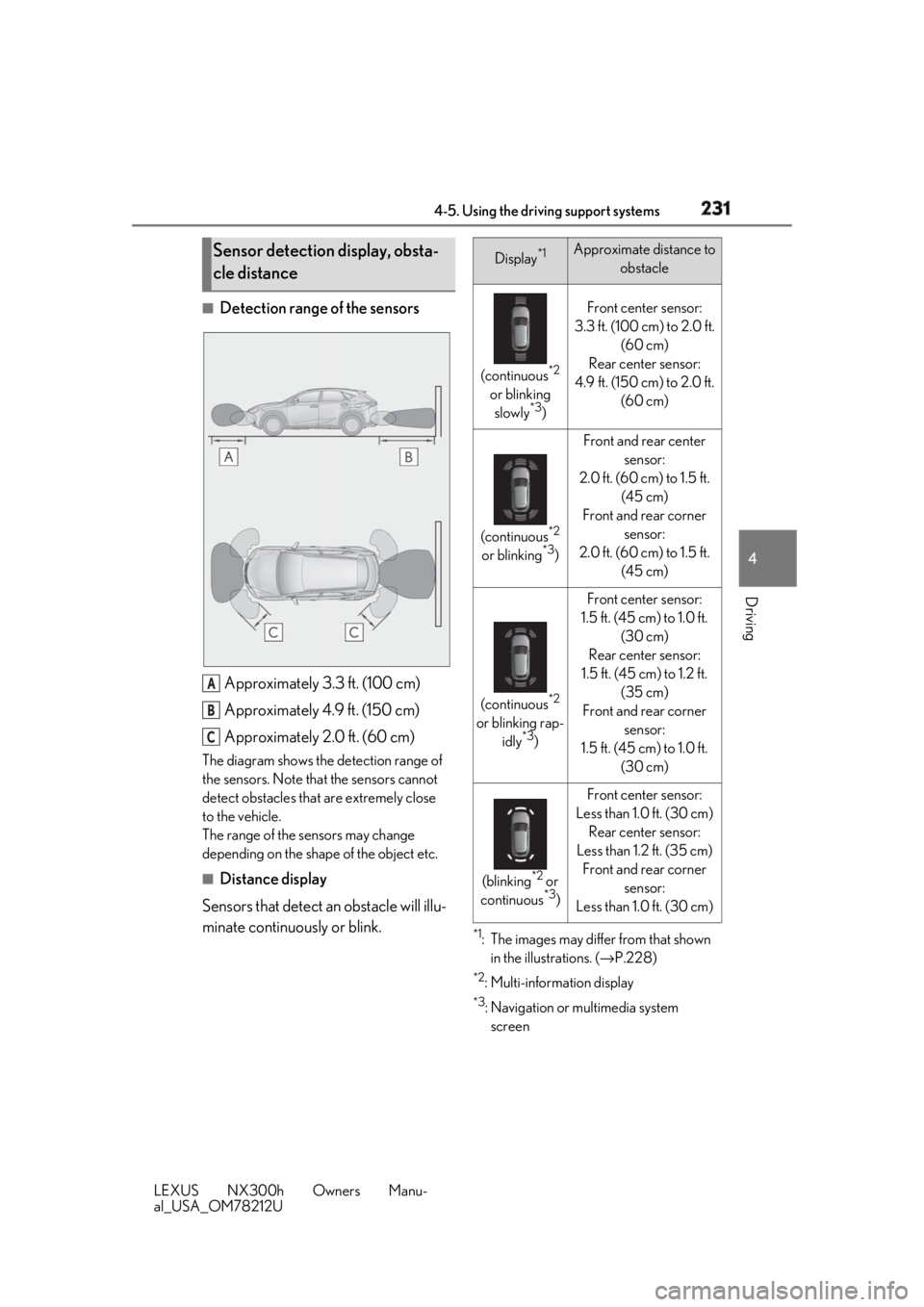diagram LEXUS NX300h 2018 Owners Manual
[x] Cancel search | Manufacturer: LEXUS, Model Year: 2018, Model line: NX300h, Model: LEXUS NX300h 2018Pages: 460, PDF Size: 13.57 MB
Page 34 of 460

34 1-1. For safe use
LEXUS NX300h Owners Manu-
al_USA_OM78212U Your vehicle is equipped with ADVANCED AIRBAGS designed based on the US motor
vehicle safety standards (FMVSS208). The airbag sensor assembly (ECU) controls airbag
deployment based on information obtained from the sensors etc. shown in the system com-
ponents diagram above. This in formation includes crash severity and occupant information.
As the airbags deploy, a chemical reaction in the inflators quic kly fills the airbags with non-
toxic gas to help restrain the motion of the occupants. ■
If the SRS airbags deploy (inflate)●
Slight abrasions, burn s, bruising, etc., may
be sustained from SRS airbags, due to the
extremely high speed deployment (infla-
tion) by hot gases.●
A loud noise and white powder will be
emitted.●
Parts of the airbag module (steering
wheel hub, airbag cover and inflator) as
well as the front seat s, parts of the front
and rear pillars, and roof side rails, may
be hot for several minutes. The airbag
itself may also be hot.●
The windshield may crack.●
For Lexus Enform Safety Connect sub-
scribers, if the SRS airbags deploy or in
the event of a severe rear-end collision,
the system is designed to send an emer-
gency call to the response center, notify-
ing them of the vehicl e’s location (without
needing to push the “SOS” button) and
an agent will attempt to speak with the
occupants to ascertain the level of emer-
gency and assistance required. If the
occupants are unable to communicate,
the agent automatically treats the call as
an emergency and help s to dispatch the
necessary emergency services.
( → P.306)
■
SRS airbag deployment conditions (SRS
front airbags)
●
The SRS front airbags will deploy in the
event of an impact that exceeds the set
threshold level (the level of force corre-
sponding to an approximately 12-18 mph
[20-30 km/h] frontal collision with a
fixed wall that does not move or deform).
However, this threshold velocity will be con-
siderably higher in the following situations:
• If the vehicle strikes an object, such as a
parked vehicle or sign pole, which can
move or deform on impact • If the vehicle is involved in an underride
collision, such as a collision in which the
front of the vehicle underrides, or goes
under, the bed of a truck ●
Depending on the type of collision, it is
possible that only the seat belt preten-
sioners will activate. ●
The SRS front airbags for the front pas-
senger will not activate if there is no pas-
senger sitting in the front passenger seat.
However, the SRS front airbags for the
front passenger may deploy if luggage is
put in the seat, even if the seat is unoccu-
pied. ( → P.41)●
The SRS seat cushion airbag on the front
passenger seat will not operate if the
occupant is not wearing a seat belt. ■
SRS airbag deployment conditions (SRS
side and curtain shield airbags) ●
The SRS side and curtain shield airbags
will deploy in the event of an impact that
exceeds the set threshold level (the level
of force corresponding to the impact
force produced by an approximately
3300 lb. [1500 kg] vehicle colliding with
the vehicle cabin from a direction per-
pendicular to the vehicle orientation at an
approximate speed of 12 -18 mph [20 -
30 km/h]). ●
The SRS curtain shield airbags will deploy
in the event of vehicle rollover.
●
The SRS side and curtain shield airbags
may also deploy in the event of a severe
frontal collision.
■
Conditions under which the SRS air-
bags may deploy (inflate), other than a
collision
The SRS front airbags and SRS side and
curtain shield airbags may also deploy if a
serious impact occurs to the underside of
your vehicle. Some examples are shown in
the illustration.
Page 231 of 460

2314-5. Using the driving support systems
LEXUS NX300h Owners Manu-
al_USA_OM78212U 4
Driving ■
Detection range of the sensors
Approximately 3.3 ft. (100 cm)
Approximately 4.9 ft. (150 cm)
Approximately 2.0 ft. (60 cm)The diagram shows the detection range of
the sensors. Note that the sensors cannot
detect obstacles that are extremely close
to the vehicle.
The range of the sensors may change
depending on the shape of the object etc.
■
Distance display
Sensors that detect an obstacle will illu-
minate continuously or blink. *1
: The images may differ from that shown
in the illustrations. ( → P.228)*2
:Multi-information display *3
: Navigation or multimedia system
screenSensor detection display, obsta-
cle distance
A
B
C Display *1
Approximate distance to
obstacle
(continuous *2
or blinking
slowly *3
) Front center sensor:
3.3 ft. (100 cm) to 2.0 ft.
(60 cm)
Rear center sensor:
4.9 ft. (150 cm) to 2.0 ft.
(60 cm)
(continuous *2
or blinking *3
) Front and rear center
sensor:
2.0 ft. (60 cm) to 1.5 ft.
(45 cm)
Front and rear corner
sensor:
2.0 ft. (60 cm) to 1.5 ft.
(45 cm)
(continuous *2
or blinking rap-
idly *3
) Front center sensor:
1.5 ft. (45 cm) to 1.0 ft.
(30 cm)
Rear center sensor:
1.5 ft. (45 cm) to 1.2 ft.
(35 cm)
Front and rear corner
sensor:
1.5 ft. (45 cm) to 1.0 ft.
(30 cm)
(blinking *2
or
continuous *3
) Front center sensor:
Less than 1.0 ft. (30 cm)
Rear center sensor:
Less than 1.2 ft. (35 cm)
Front and rear corner
sensor:
Less than 1.0 ft. (30 cm)